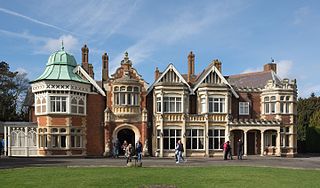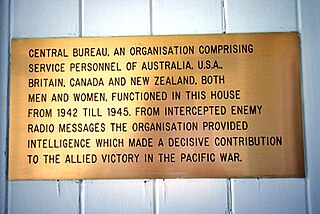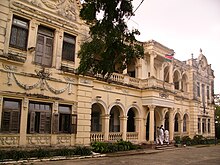
Bletchley Park is an English country house and estate in Bletchley, Milton Keynes (Buckinghamshire) that became the principal centre of Allied code-breaking during the Second World War. The mansion was constructed during the years following 1883 for the financier and politician Herbert Leon in the Victorian Gothic, Tudor and Dutch Baroque styles, on the site of older buildings of the same name.

Fish was the UK's GC&CS Bletchley Park codename for any of several German teleprinter stream ciphers used during World War II. Enciphered teleprinter traffic was used between German High Command and Army Group commanders in the field, so its intelligence value (Ultra) was of the highest strategic value to the Allies. This traffic normally passed over landlines, but as German forces extended their geographic reach beyond western Europe, they had to resort to wireless transmission.
The vulnerability of Japanese naval codes and ciphers was crucial to the conduct of World War II, and had an important influence on foreign relations between Japan and the west in the years leading up to the war as well. Every Japanese code was eventually broken, and the intelligence gathered made possible such operations as the victorious American ambush of the Japanese Navy at Midway in 1942 and the shooting down of Japanese admiral Isoroku Yamamoto a year later in Operation Vengeance.

Room 40, also known as 40 O.B., was the cryptanalysis section of the British Admiralty during the First World War.
Cryptography was used extensively during World War II because of the importance of radio communication and the ease of radio interception. The nations involved fielded a plethora of code and cipher systems, many of the latter using rotor machines. As a result, the theoretical and practical aspects of cryptanalysis, or codebreaking, were much advanced.

The Indian Ocean raid, also known as Operation C or Battle of Ceylon in Japanese, was a naval sortie carried out by the Imperial Japanese Navy (IJN) from 31 March to 10 April 1942. Japanese aircraft carriers under Admiral Chūichi Nagumo struck Allied shipping and naval bases around British Ceylon, but failed to locate and destroy the bulk of the British Eastern Fleet. The Eastern Fleet, commanded by Admiral Sir James Somerville, was forewarned by intelligence and sailed from its bases prior to the raid; its attempt to attack the Japanese was frustrated by poor tactical intelligence.
Station CAST was the United States Navy signals monitoring and cryptographic intelligence fleet radio unit at Cavite Navy Yard in the Philippines, until Cavite was captured by the Japanese forces in 1942, during World War II. It was an important part of the Allied intelligence effort, addressing Japanese communications as the War expanded from China into the rest of the Pacific theaters. As Japanese advances in the Philippines threatened CAST, its staff and services were progressively transferred to Corregidor in Manila Bay, and eventually to a newly formed US-Australian station, FRUMEL in Melbourne, Australia.

The Central Bureau was one of two Allied signals intelligence (SIGINT) organisations in the South West Pacific area (SWPA) during World War II. Central Bureau was attached to the headquarters of the Supreme Commander, Southwest Pacific Area, General Douglas MacArthur. The role of the Bureau was to research and decrypt intercepted Imperial Japanese Army traffic and work in close co-operation with other SIGINT centers in the United States, United Kingdom and India. Air activities included both army and navy air forces, as there was no independent Japanese air force.

Kilindini Harbour is a large, natural deep-water inlet extending inland from Mombasa, Kenya. It is 25–30 fathoms (46–55 m) at its deepest center, although the controlling depth is the outer channel in the port approaches with a dredged depth of 17.5 m (57 ft). It serves as the harbour for Mombasa, with a hinterland extending to Uganda. Kilindini Harbour is the main part of the Port of Mombasa, the only international seaport in Kenya and the biggest port in east Africa. It is managed by the Kenya Ports Authority (KPA). Apart from cargo handling, Mombasa is frequented by cruise ships.

Fleet Radio Unit, Melbourne (FRUMEL) was a United States–Australian–British signals intelligence unit, founded in Melbourne, Australia, during World War II. It was one of two major Allied signals intelligence units called Fleet Radio Units in the Pacific theatre, the other being FRUPAC, in Hawaii. FRUMEL was a U.S. Navy organization, reporting directly to CINCPAC in Hawaii and the Chief of Naval Operations in Washington, D.C., and hence to the central cryptographic organization. The separate Central Bureau in Melbourne was attached and reported to General Douglas MacArthur's Allied South West Pacific Area command headquarters.
Before the development of radar and other electronics techniques, signals intelligence (SIGINT) and communications intelligence (COMINT) were essentially synonymous. Sir Francis Walsingham ran a postal interception bureau with some cryptanalytic capability during the reign of Elizabeth I, but the technology was only slightly less advanced than men with shotguns, during World War I, who jammed pigeon post communications and intercepted the messages carried.
Hut 7 was a wartime section of the Government Code and Cypher School (GC&CS) at Bletchley Park tasked with the solution of Japanese naval codes such as JN4, JN11, JN40, and JN-25. The hut was headed by Hugh Foss who reported to Frank Birch, the head of Bletchley's Naval section.
The Wireless Experimental Centre (WEC) was one of two overseas outposts of Station X, Bletchley Park, the British signals analysis centre during World War II. The other outpost was the Far East Combined Bureau. Codebreakers Wilfred Noyce and Maurice Allen broke the Japanese Army's Water Transport Code here in 1943, the first high-level Japanese Army code broken. John Tiltman broke prewar Russian and Japanese codes at Simla and Abbottabad.
The 1943 BRUSA Agreement was an agreement between the British and US governments to facilitate co-operation between the US War Department and the British Government Code and Cypher School (GC&CS). It followed the 1942 Holden Agreement.
Fleet Radio Units (FRU) were the major centers for Allied cryptological and signals intelligence during the Pacific Campaign of World War II. Initially two FRUs were established in the Pacific, one at Pearl Harbor, Hawaii, called Station HYPO or FRUPAC, and the other, called Station CAST or Belconnen, at Cavite Naval Yard, then Corregidor, Philippines. With the fall of the Philippines to Imperial Japanese forces in April and May 1942, CAST personnel were evacuated to a newly established FRU at Melbourne, Australia, called FRUMEL.
Captain Eric Nave was an Australian cryptographer and intelligence officer in the Royal Australian Navy (RAN) and Royal Navy, noted for his work with joint Allied intelligence units during World War II. He served in the navy from 1916 to 1949, then served as an officer in the Australian Security Intelligence Organisation until 1959.
Japanese army and diplomatic codes. This article is on Japanese army and diplomatic ciphers and codes used up to and during World War II, to supplement the article on Japanese naval codes. The diplomatic codes were significant militarily, particularly those from diplomats in Germany.
Arthur Richard Valentine Cooper (1916–1988) was a British codebreaker, who became a translator of Chinese literature after retirement. He is best remembered for his translations of the Tang dynasty poets Li Bai and Du Fu, but is also known for his original research on the early Chinese script.

During the First World War, the Commander-in-Chief at the Cape, Rear Admiral Herbert King-Hall, expended much effort to destroy the elusive German light cruiser Königsberg.








